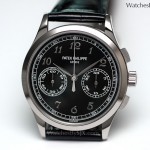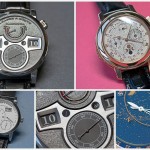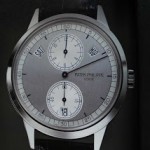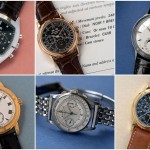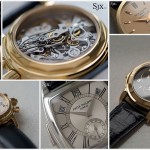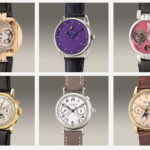Highlights: Vintage Patek Philippe – and One Special Day-Date – at Sotheby’s Hong Kong
Significant, historical, and unique.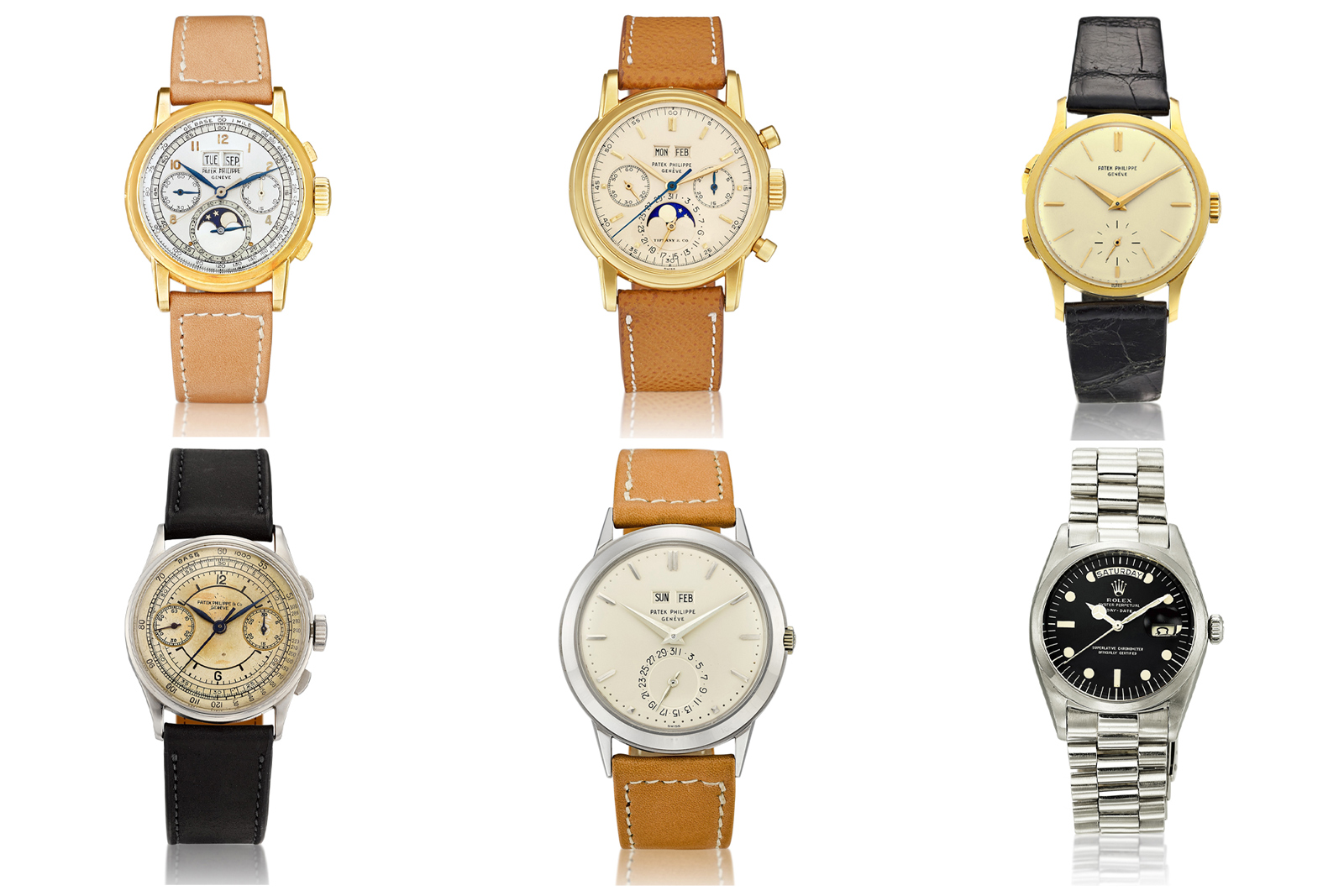
With Sotheby’s Hong Kong sale just around the corner, we’re rounding up a half-dozen notable vintage watches from the auction, primarily big-ticket Patek Philippe complications. Amongst them a few oddities, one a Patek Philippe ref. 3448 “Senza Luna”, a perpetual calendar with the moon phase omitted, and the other the Rolex Day-Date with a “Submariner” dial.
With the preview exhibition open daily from now till October 12, the auction will take place on October 13. The catalogue and registration for bidding are available on Sothebys.com.
Lot 2265: Patek Philippe ref. 130
The oldest watch of the selection is a Patek Philippe ref. 130, the brand’s first serially-produced wristwatch chronograph that remained in the catalogue for over three decades.
The model’s longevity makes it an inevitability that a good number of ref. 130 variants exist. Indeed, the model varies greatly in terms case material and dial design, with some combinations being rarer than others. One such rare combination is a steel case with “sector” dial, like the present example.
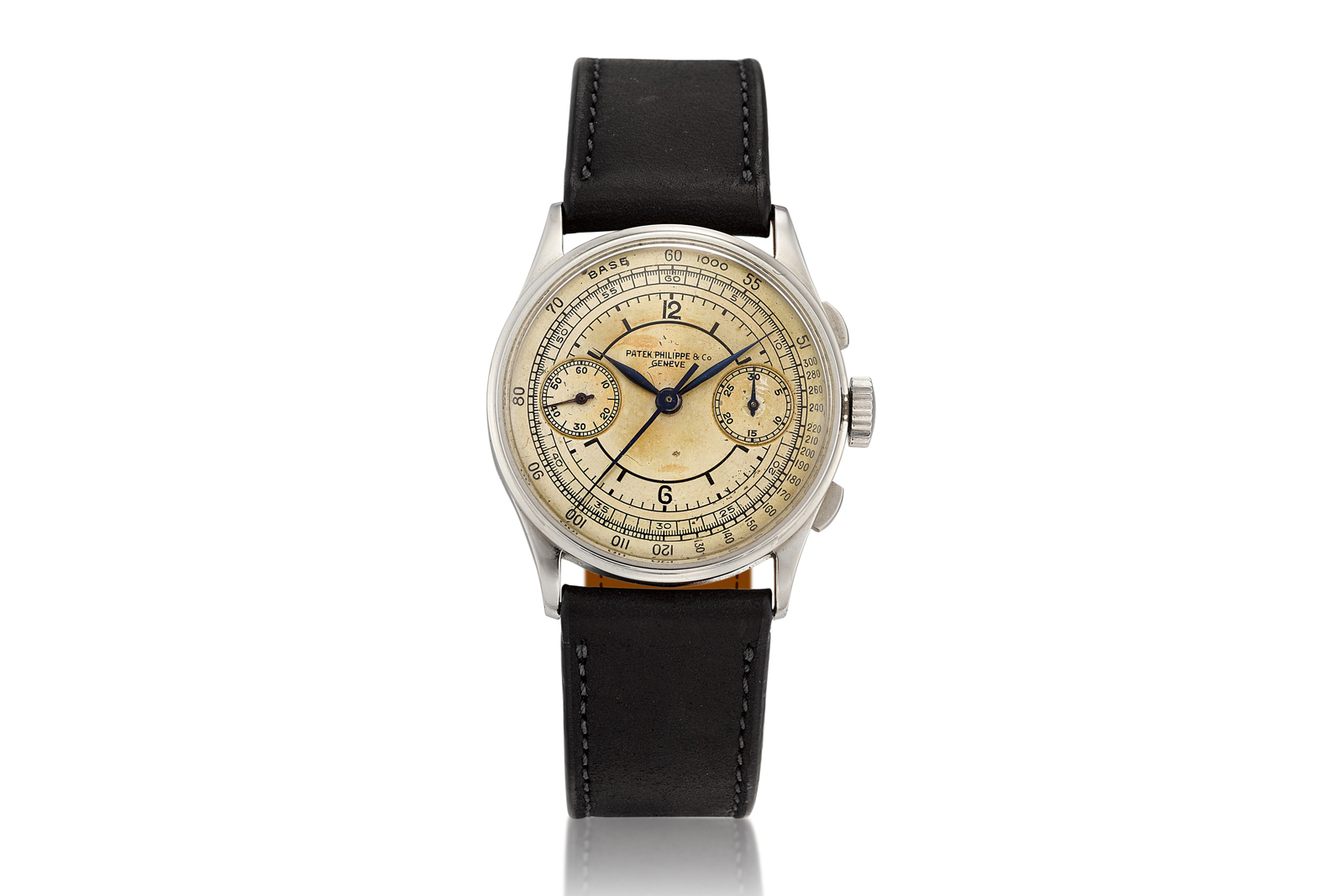
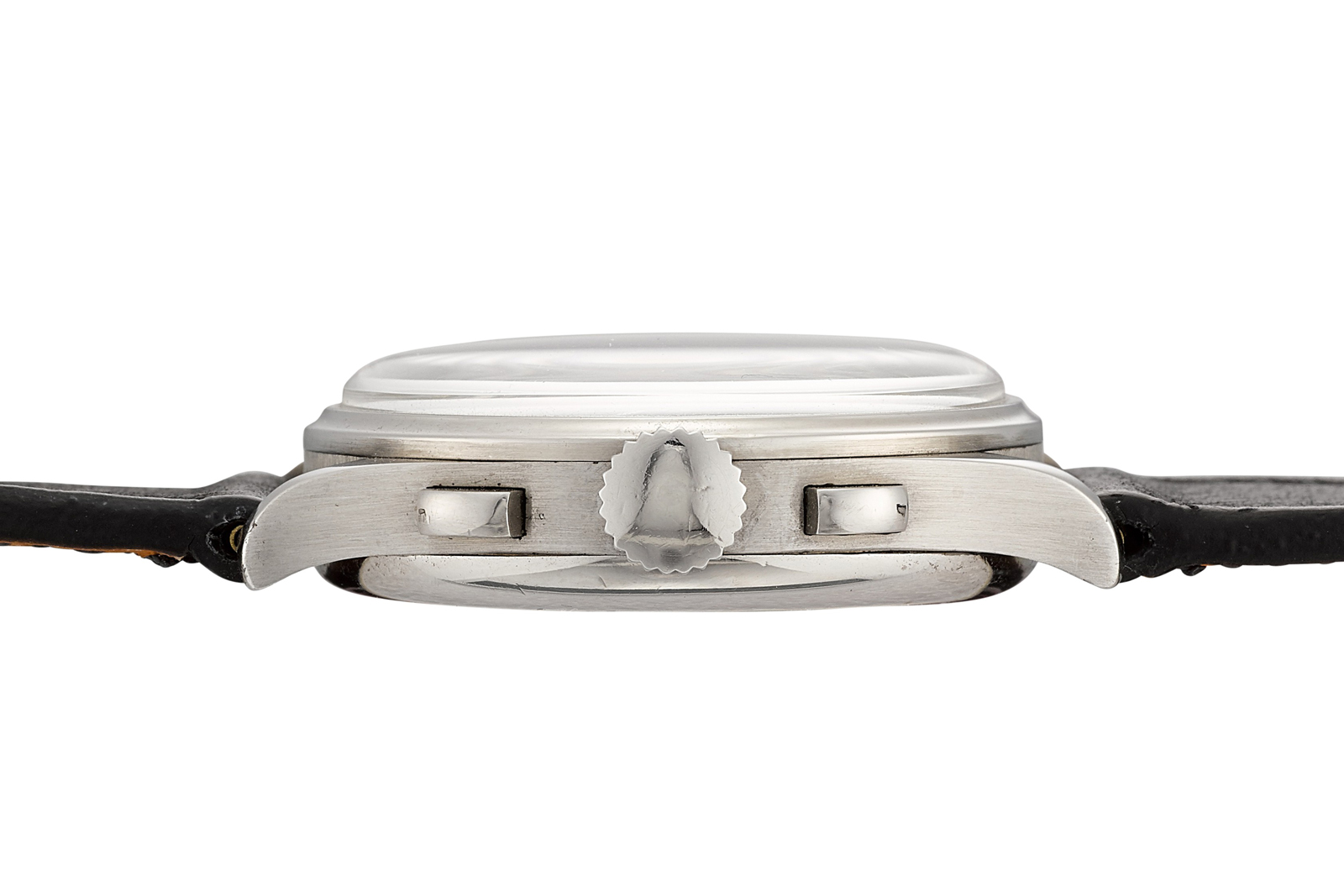
Made by Wenger, the steel cases of the ref. 130 have shorter and wider-spaced lugs compared to the gold cases that made by Vichet, giving the 33 mm case a more imposing appearance
Chronograph wristwatches from that era typically feature tiny counters that sit close to the edge of the dial, leaving the dial clean and distinctly vintage. But the “sector” dial here is an entirely different animal – the sectored chapter rings for minutes and hours, together with the tachymeter scale, give the watch an aesthetic not found on the typical ref. 130.
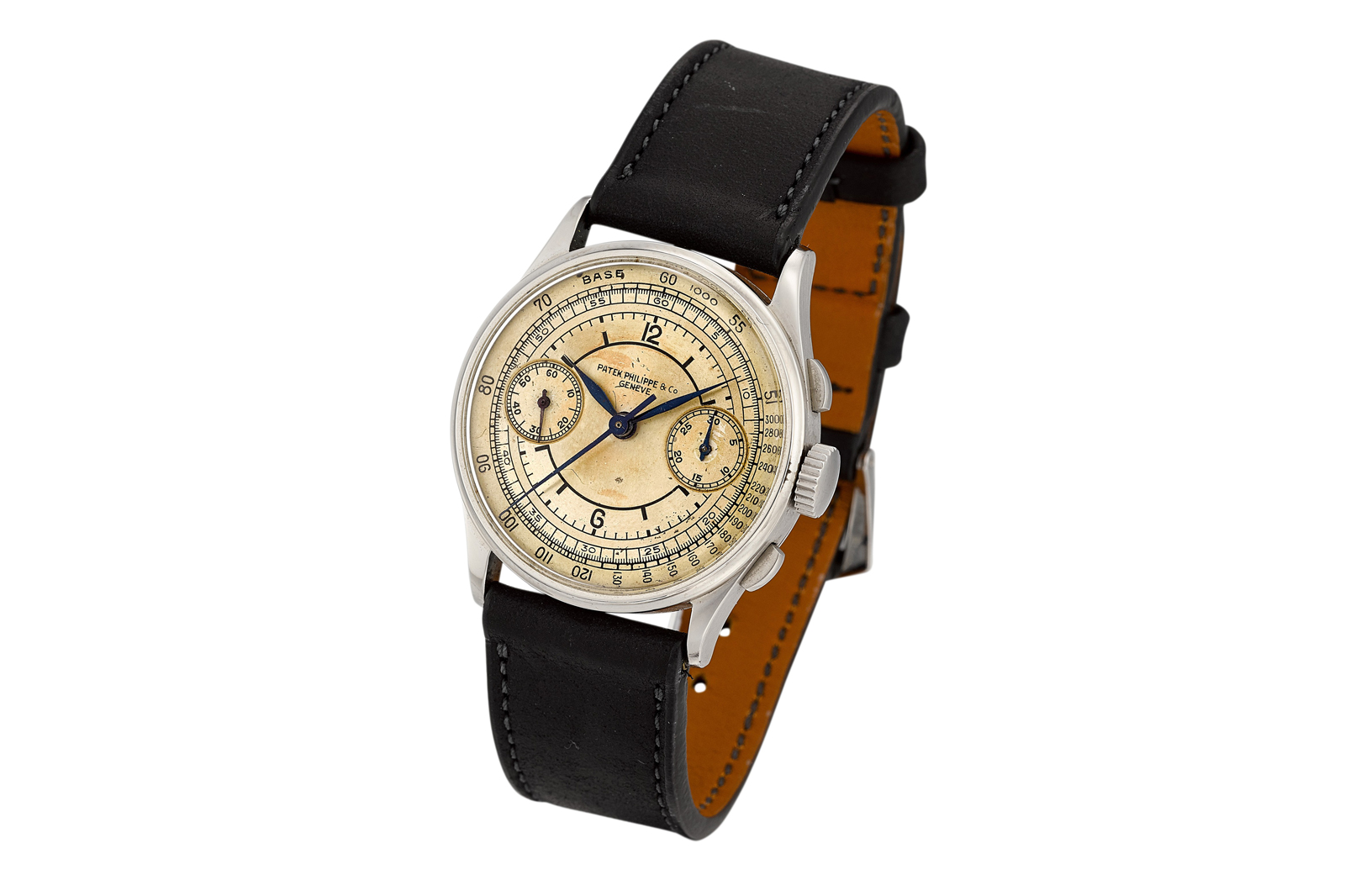
The enamelled track is intact, but dial shows uneven ageing
Another tasteful detail found on the dial are the champleve enamel markings – they were first engraved and then filled with enamel, before being fired and lightly sanded, leaving the markings slightly raised above the dial’s surface – which will look entirely different from a printed dial.
This watch boasts an original dial, with the enamelling markings intact – but showing significant signs of age, including discolouration of the lacquer and tool marks from removal of the hands during servicing.
This can be had for an estimate of HK$2.4-4.8 million, or around US$308,000-617,000. Full lot details here.
Lot 2262: Patek Philippe ref. 2499 first series
While the ref. 130 above is evidently original and revels in its decades, the next lot is crisp and unusually new, having been restored in the 1990s. This is a first-series ref. 2499, one of two in the sale. It is fresh to market, having been in the current owner’s collection since the 1990s.
Succeeding the ref. 1518 – the first serially-produced chronograph with perpetual calendar – the ref. 2499 was produced in four distinct series, with the first being the the most sought and valuable.
Amongst the details that set the first series apart are the classical, rectangular pushers, in contrast to the subsequent models that have round pushers, which are easier to seal hence more water resistant.
One other details that characterise the ref. 2499 – and are found on the subsequent ref. 3970 – are the fluted lugs. The fluting on the lugs are especially pronounced on this example, a result of its restoration.
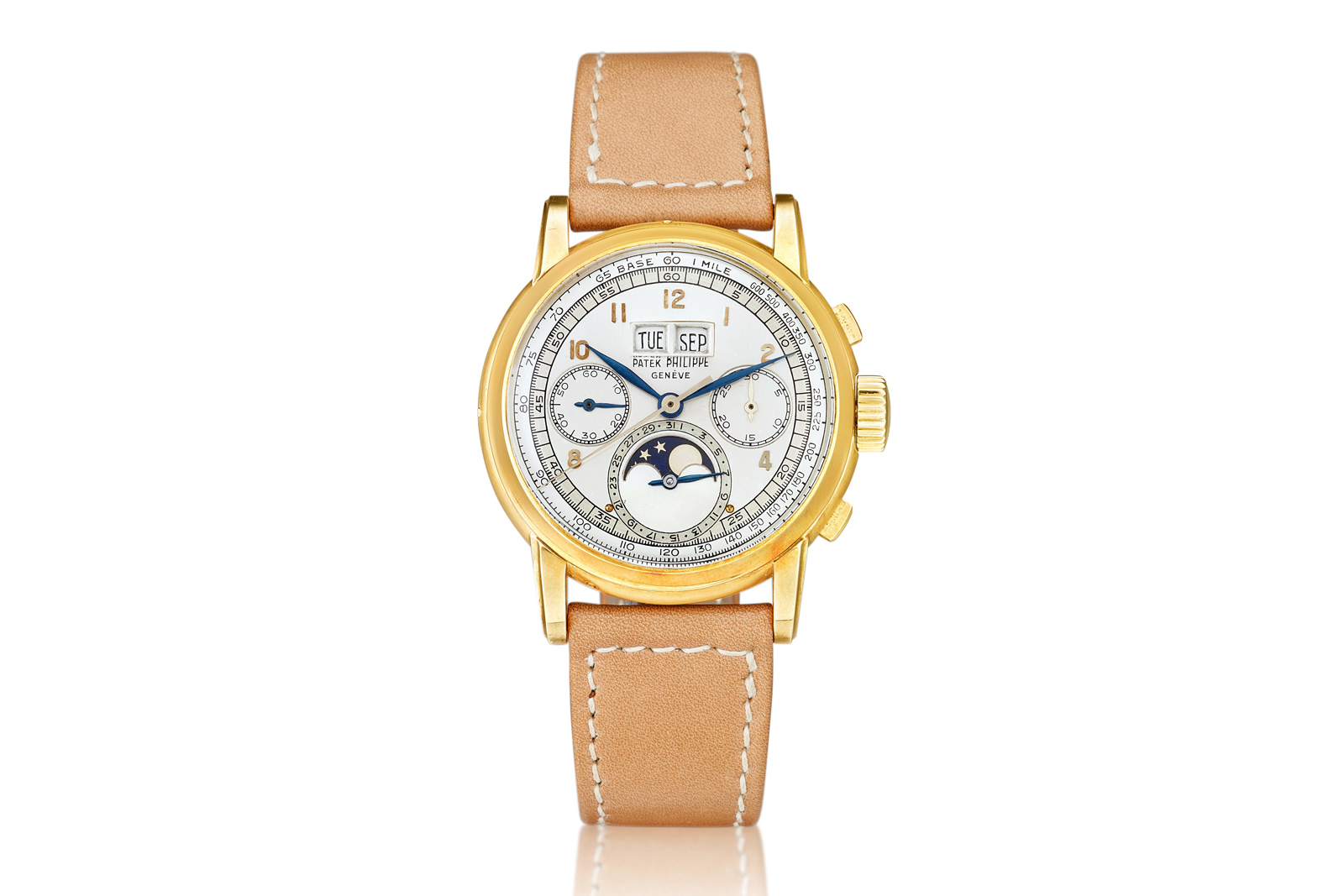
Best summed up as a larger and more expressive version of the tiny ref. 1518, the ref. 2499 is a sizeable 37.5 mm in diameter, making it notably suited to modern tastes despite being a watch from the 1950s, when the average men’s watch was 33 mm or so.
Most of the cases, particularly for the latter series – of which this is an example – were made by Wenger, which took over Vichet, the firm that supplied the earliest ref. 2499 cases. Notably the Vichet cases were slightly smaller at 36 mm.
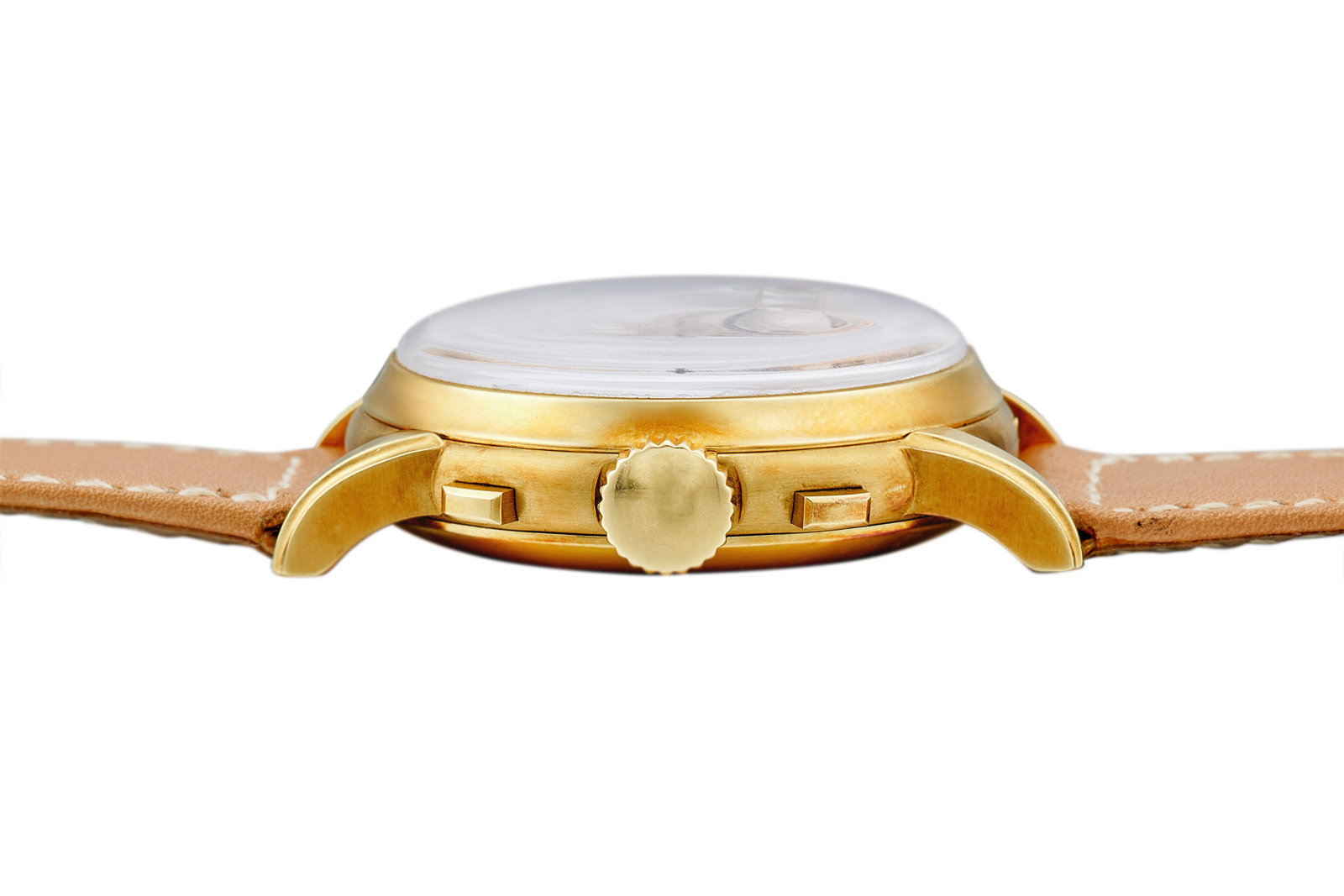
The lugs have fluting on their top edges and arch downwards
Besides the case restoration, the dial was also cleaned at the same, while the original gilt hands were striking by striking blued steel hands. And a magnifier for the day and month display was added to the crystal.
Although the watch has been modified from its original state, the work is sympathetic and doesn’t detract from its visual appeal. While a traditionalist would surely frown on the restoration, it does result in a watch that might make for good everyday wear, since there is a reduced need to preserve it as is.
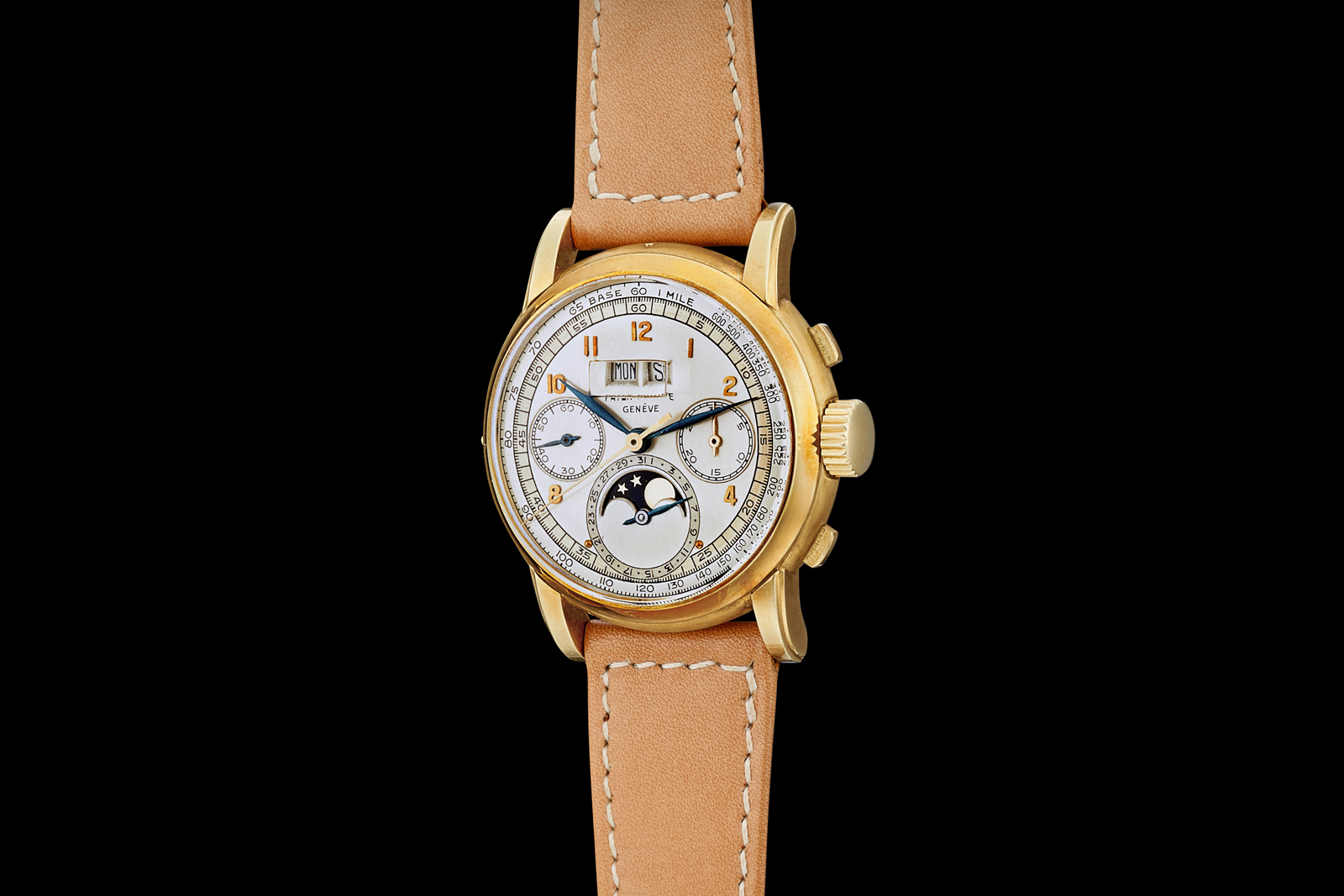
Unsurprisingly, the estimate is lower than usual for a first-series ref. 2499, though it’s still a hefty HK$8.0-12 million, or around US$1.03-1.54 million. Full lot details here.
Lot 2264: Patek Philippe ref. 2499 third series
The next highlight is another ref. 2499, but a slightly more affordable variant – a third series, the most common of the four. On its face, the third-series ref. 2499 is clearly different from its predecessors. Amongst the differences is the absence of a tachymeter, which immediately gives the dial a more spacious look. Another are the baton indices that replaced the Arabic numerals of the first series.
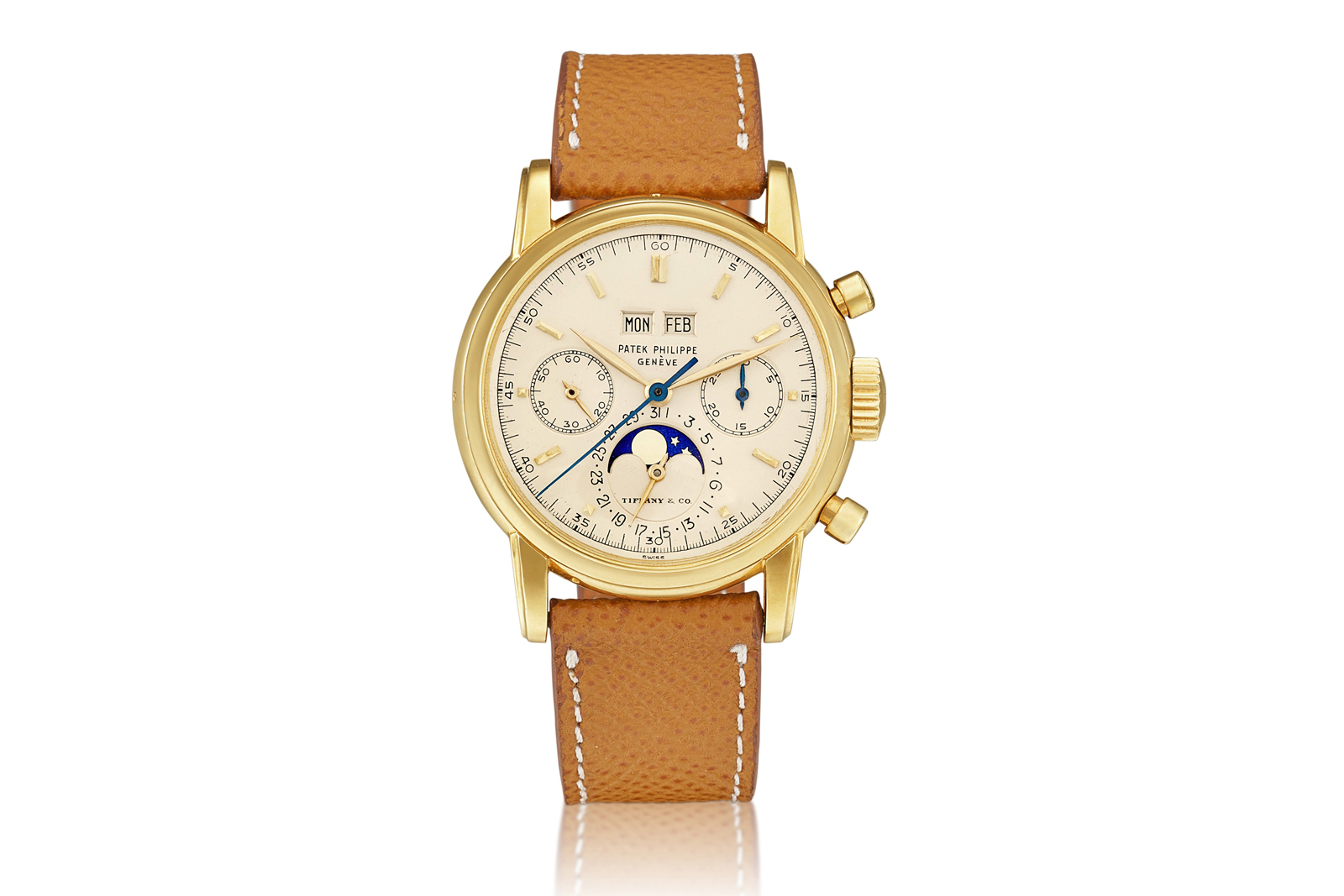
That said, this example is a special third series, distinguished by the Tiffany & Co. signature on the dial, making it significantly more valuable than the typical third-series watch.
While Tiffany-signed dials are exceptionally desirable today, they are rare when its comes to vintage Patek Philippe complications – Sotheby’s estimates that less than six third-series ref. 2499s were signed “Tiffany & Co.”.
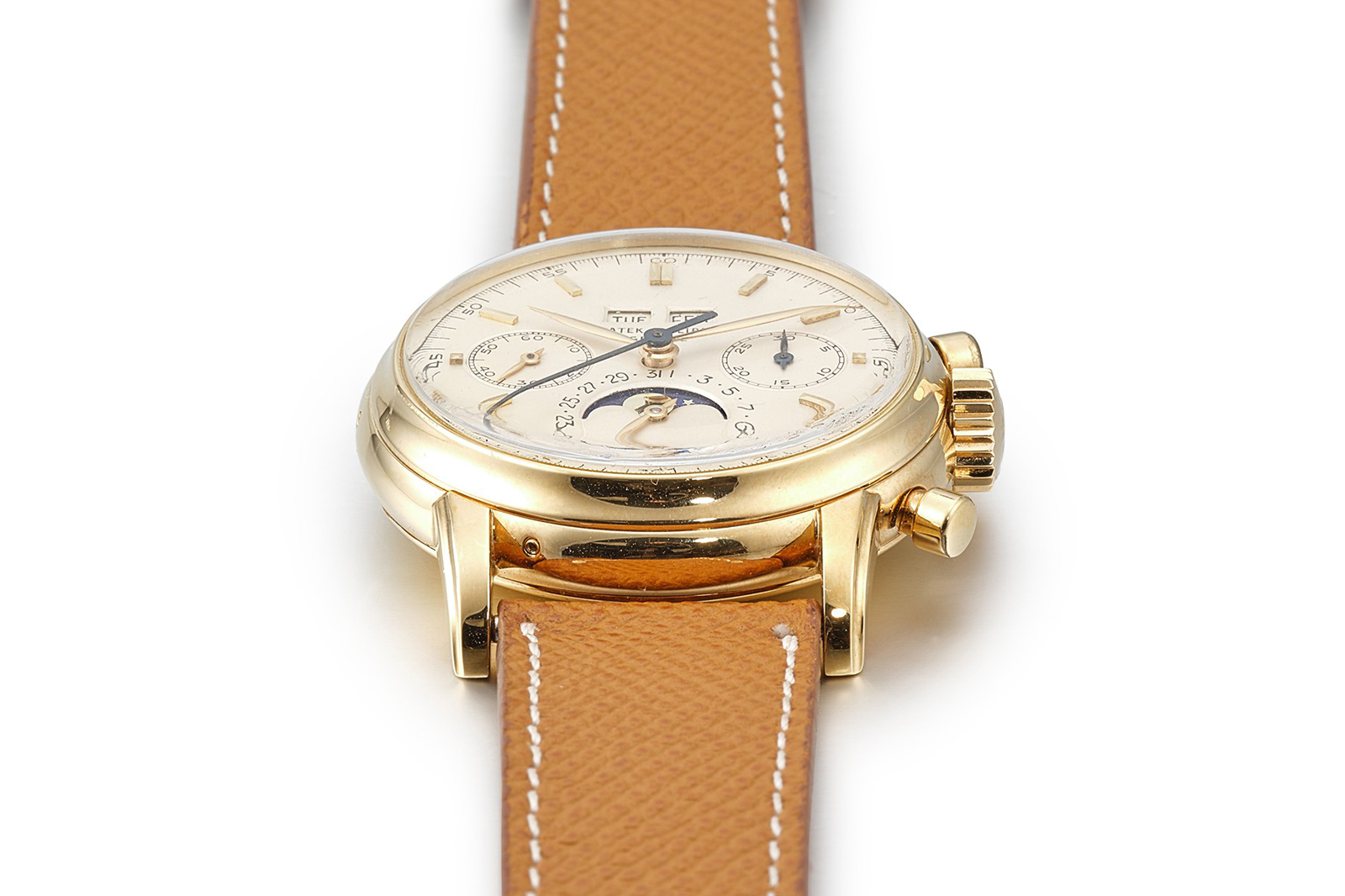
Simply gorgeous
Notably, the movement of this watch is stamped “HOX” on the balance cock, a hallmark for watches sold in America, a reassuring detail for a watch double-signed by the American jeweller.
Showing some wear and retaining its enamelled markings, the Tiffany-signed dial is original, but the case of the watch has been restored in the last decade. Specifically, the fluting on the lugs has been “enhanced” according to Sotheby’s, giving the case the defined lines typical of a more recent watch.
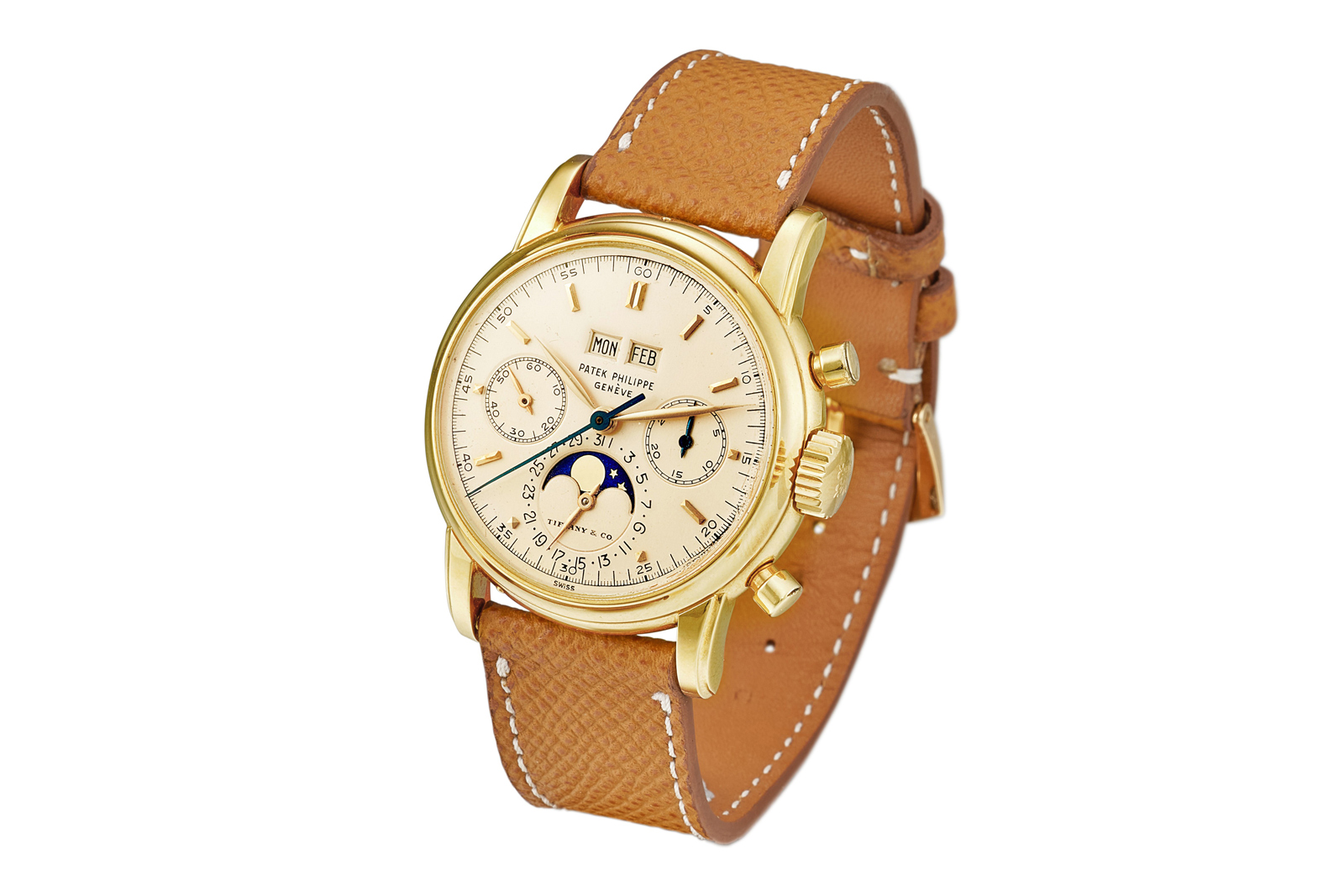
Sold by the descendants of the original owner at Sotheby’s in 2007, where it achieved US$361,000 including fees, this now has an estimate of HK$4.0-8.0 million, or around US$514,000-1.03 million. Full lot details here.
Lot 2263: Patek Philippe ref. 3448 “Senza Luna”
Up next is the unusual ref. 3448 “Senza Luna”, resplendent in its monochromatic simplicity but also occasionally controversial. Senza luna is Italian for “without moon”, which sums up the omission that makes this watch special.
The “Senza Luna” watches are controversial because a good number of them are regarded as having been modified by parties other than Patek Philippe. The most famous example of the “Senza Luna”, however, is eminently legit: it was made for longtime Patek Philippe sales director Alan Banbery and it most recently sold for over US$3.7 million at Christies.
This example of the “Senza Luna” is accompanied by a crucial bit of documentation: an archive extract that confirms it was made without the moon phase, meaning that the moon-less dial is kosher.
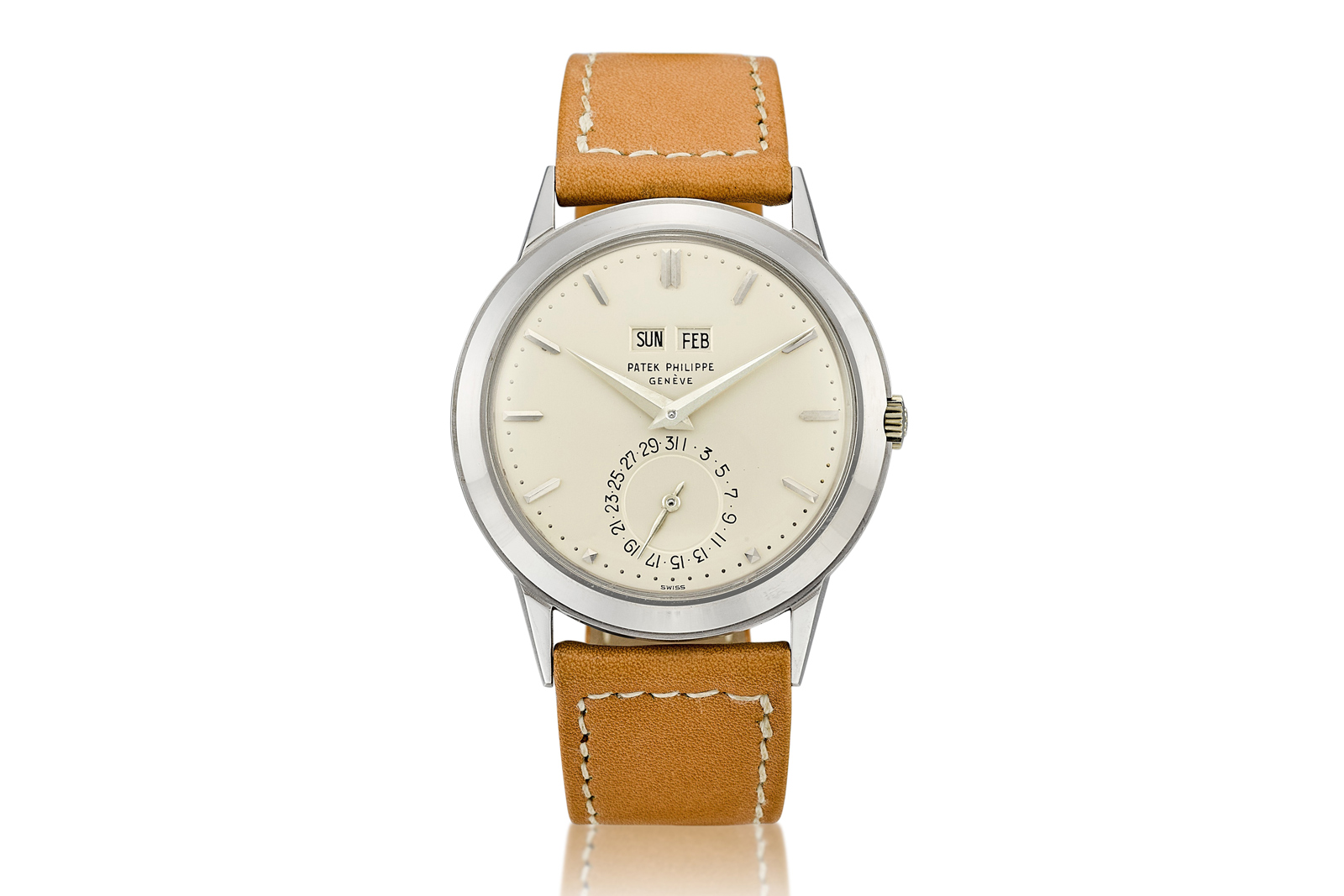
While the missing moon is the distinguishing feature of the present example, the ref. 3448 is notable in its own right. To start with, it was the brand’s first-ever automatic perpetual calendar, a more sensible set-up than earlier models powered by hand-wind movements since the entire point of a perpetual calendar is to minimise fiddling with the watch. And then there’s the fact that 586 examples of the ref. 3448 were made, of which 130 were in white gold.
The rarity of the model, however, is only part of its appeal. The attraction of the ref. 3448 is compounded by the fact that the design is unusually sleek, with a clean, symmetrical dial matched with a sizeable case featuring angular lugs.
Only the most important elements made it onto the dial, which does away with the leap year indicator and running seconds, making it strikingly different from Patek Philippe’s earlier perpetual calendar models such as ref. 1526 and ref. 2497, and even its successors like the ref. 3450 and ref. 3940.
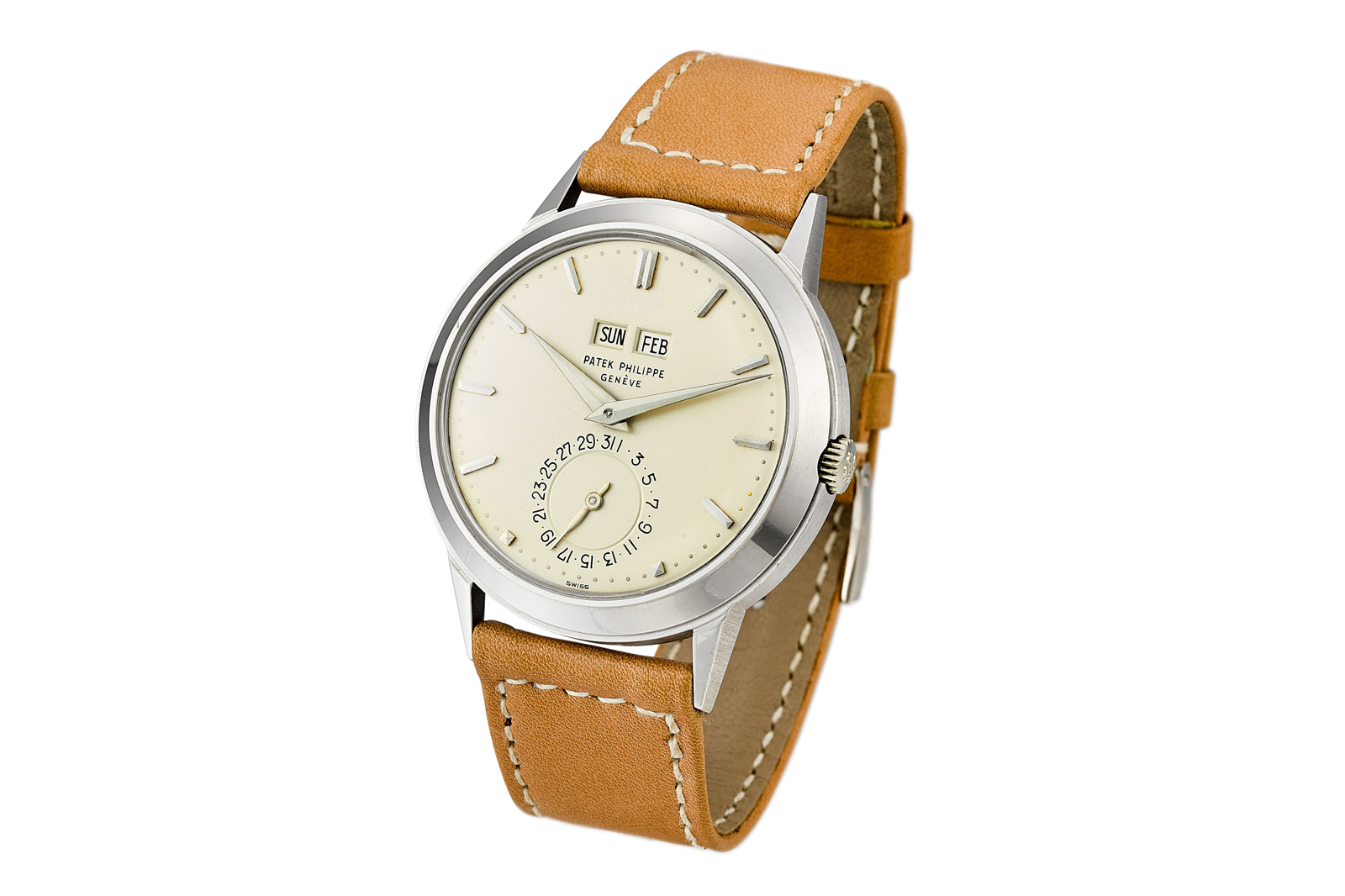
But the best part is the case, which is masculine and emotive. In fact, the case of ref. 3448 is as straightforward as the dial, with neither steps nor fluting, but instead strong, clean facets. It’s spectacular in its restraint and simplicity.
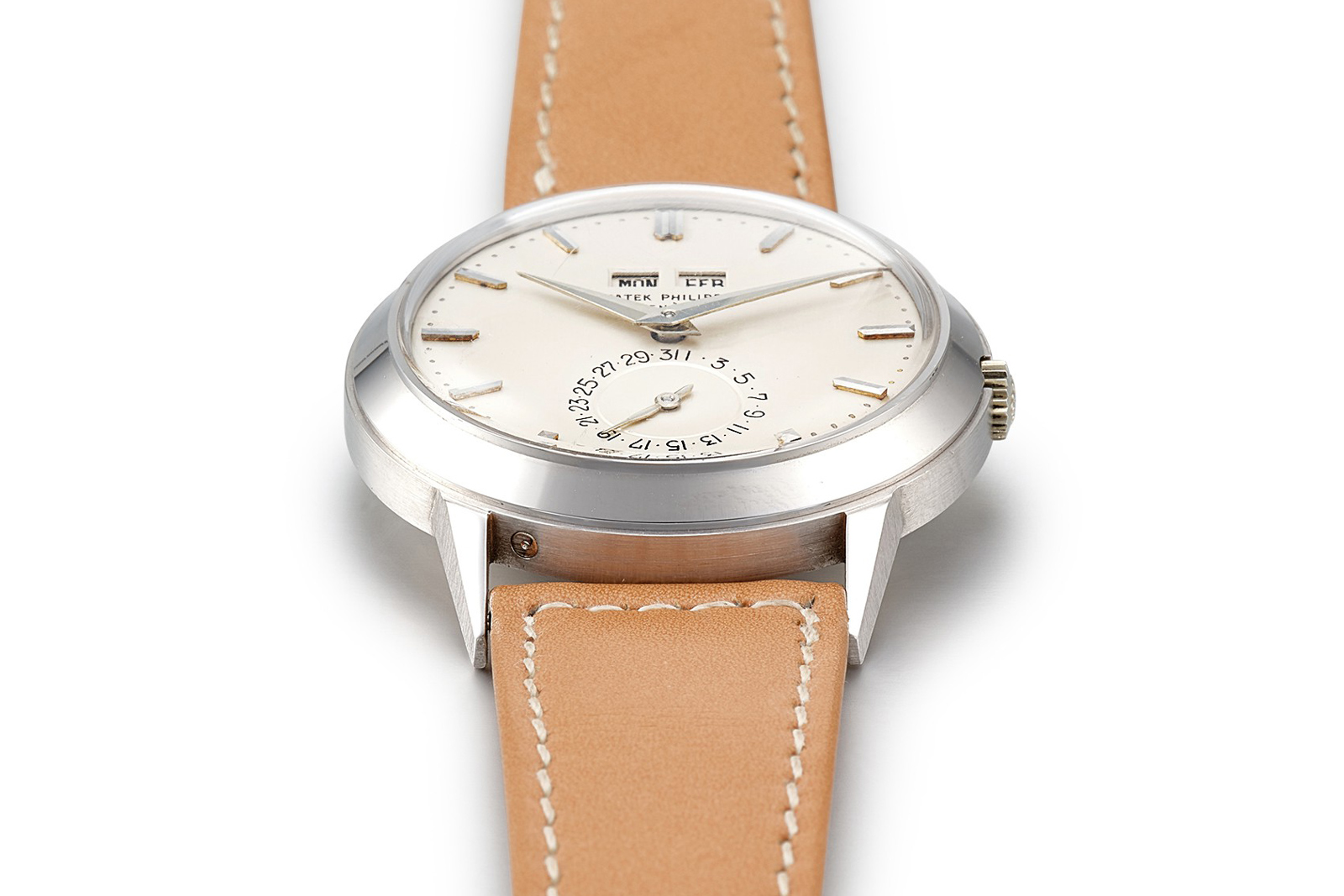
Perfect proportions
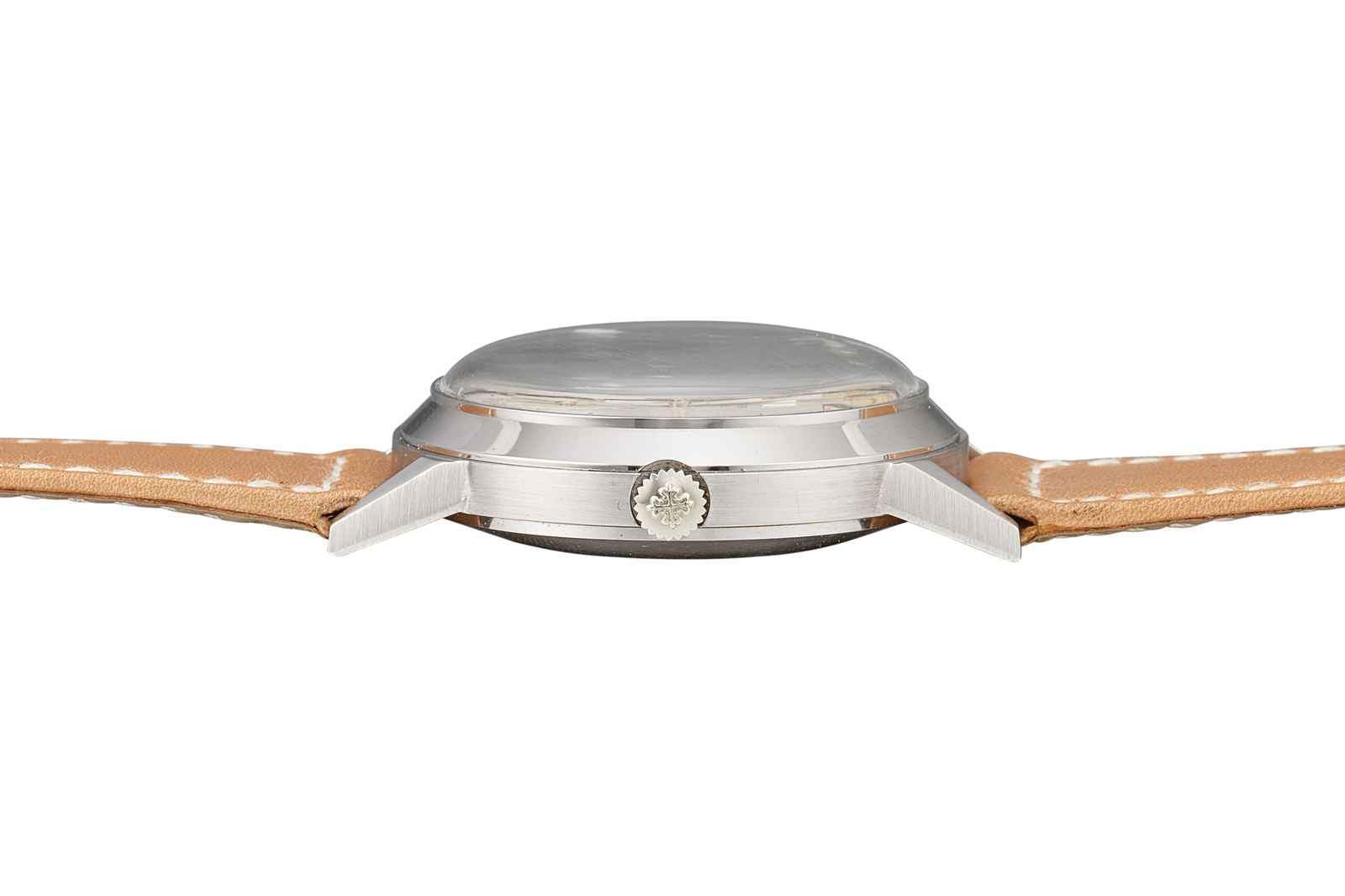
And razor sharp edges
This specific watch lacks the moon phase found at six o’clock on the standard ref. 3448 – though the moon phase mechanism remains under the dial along with the corrector pusher at seven o’clock.
It’s a small difference that matters for two reasons. One is philosophical – the moon phase is arguably romantic and unnecessary given the concise design.
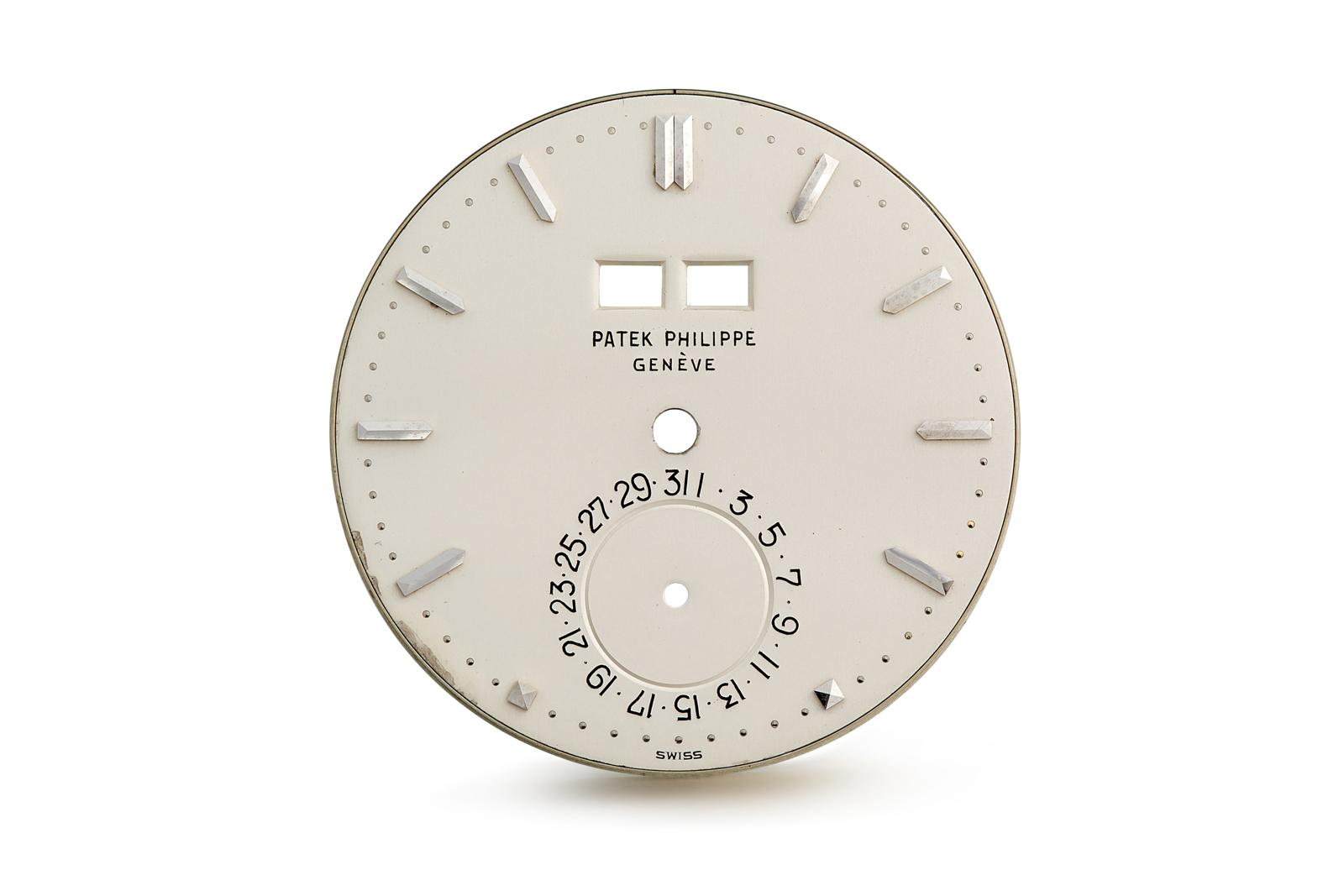
The other is sheer rarity. Only seven “Senza Luna” are known, three each in yellow and white gold, plus the Banbery watch. While most of the “Senza Luna” watches have disputed provenance, this example has an all-important extract confirming the dial.
Having last sold at Christie’s in 2017 for almost US$1 million, the ref. 3448 “Senza Luna” has an estimate of HK$4.8-6.5 million, or around US$617,000-835,000. Full lot details here.
Lot 2266: Patek Philippe ref. 2597 Travel Time
The final Patek Philippe highlight is the ref. 2597 Travel Time – the very same complication now synonymous with the brand’s sport watches originated with this watch. A historically important watch, the ref. 2597 belongs to the lineage of world time and dual time watches made by Patek Philippe, most of which were invented in the era when international travel began to take off, first by sea, and then by plane.
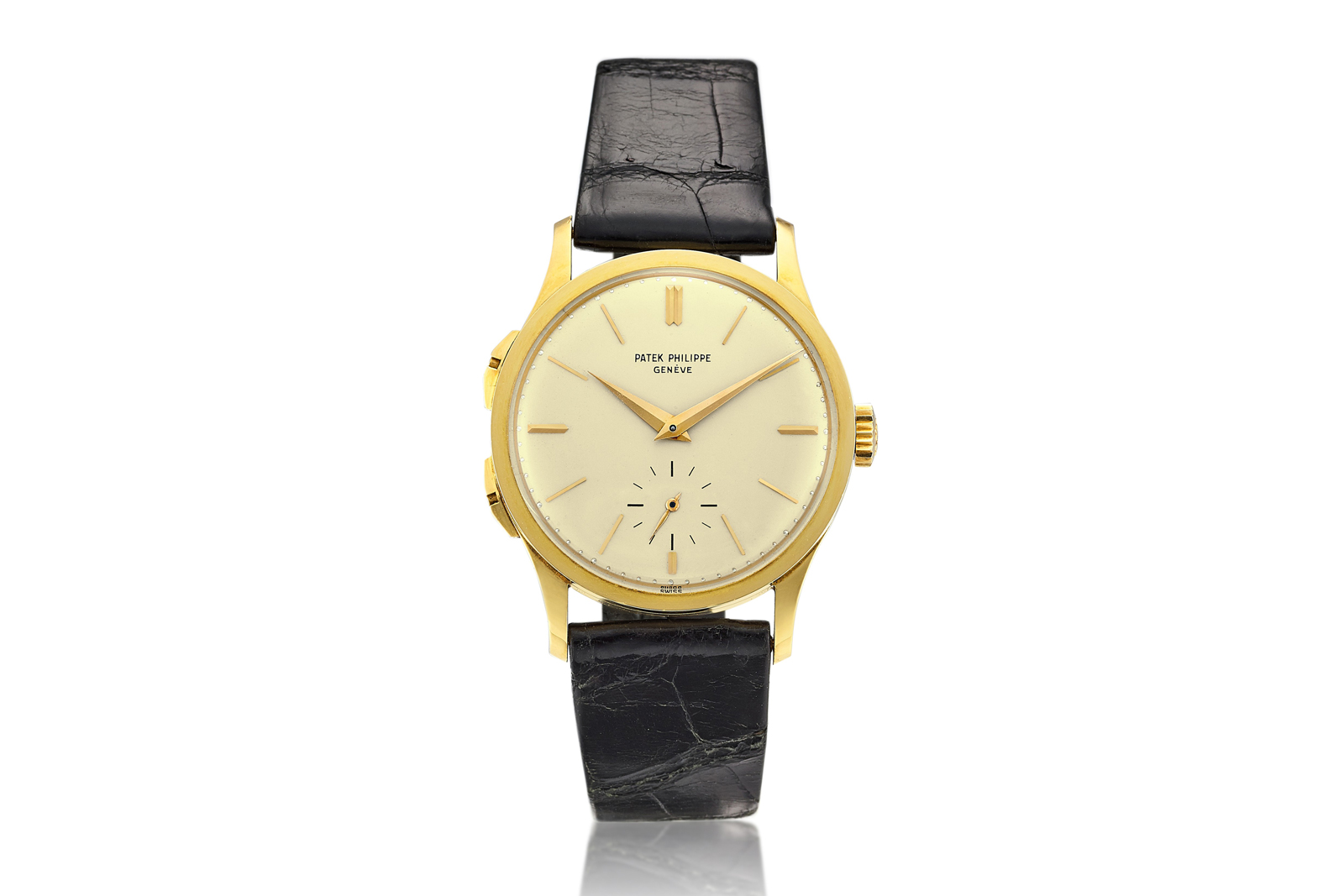
Officially introduced in 1958, just as the Jet Age was in its infancy, the ref. 2597 is significantly different from its predecessors, which were world-time watches invented by Louis Cottier.
Those watches had a world time mechanism made up of conventional, central hands set that show local time, plus a 24-hour ring that rotates once a day, along with a cities ring indicates the time in other locations.
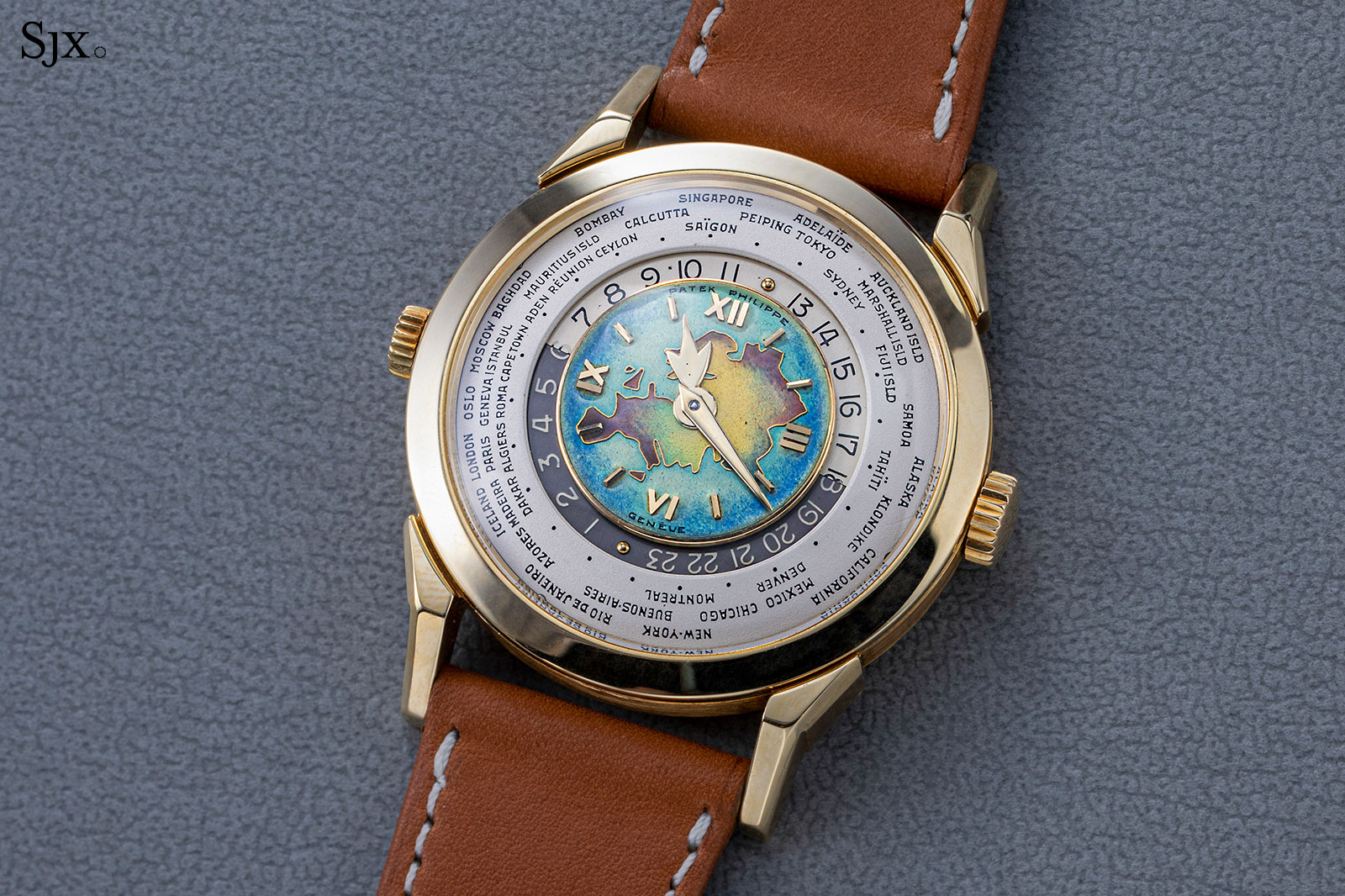
The ref. 2523 world time
While world time watches conveniently show the time around the world, they are less legible due to the size of the twin world-time rings. As jet travel made crossing time zones easier, travellers began to care only about the time at the destination rather than everywhere, resulting in dual-time zone watches.
This period saw the debut of the Rolex GMT-Master ref. 6542, developed at the request of Pan American Airways. And Patek Philippe’s contribution to this era was the ref. 2597, a Travel Time watch with twin buttons in the case band that allow for adjusting the hour hand forwards and backwards.
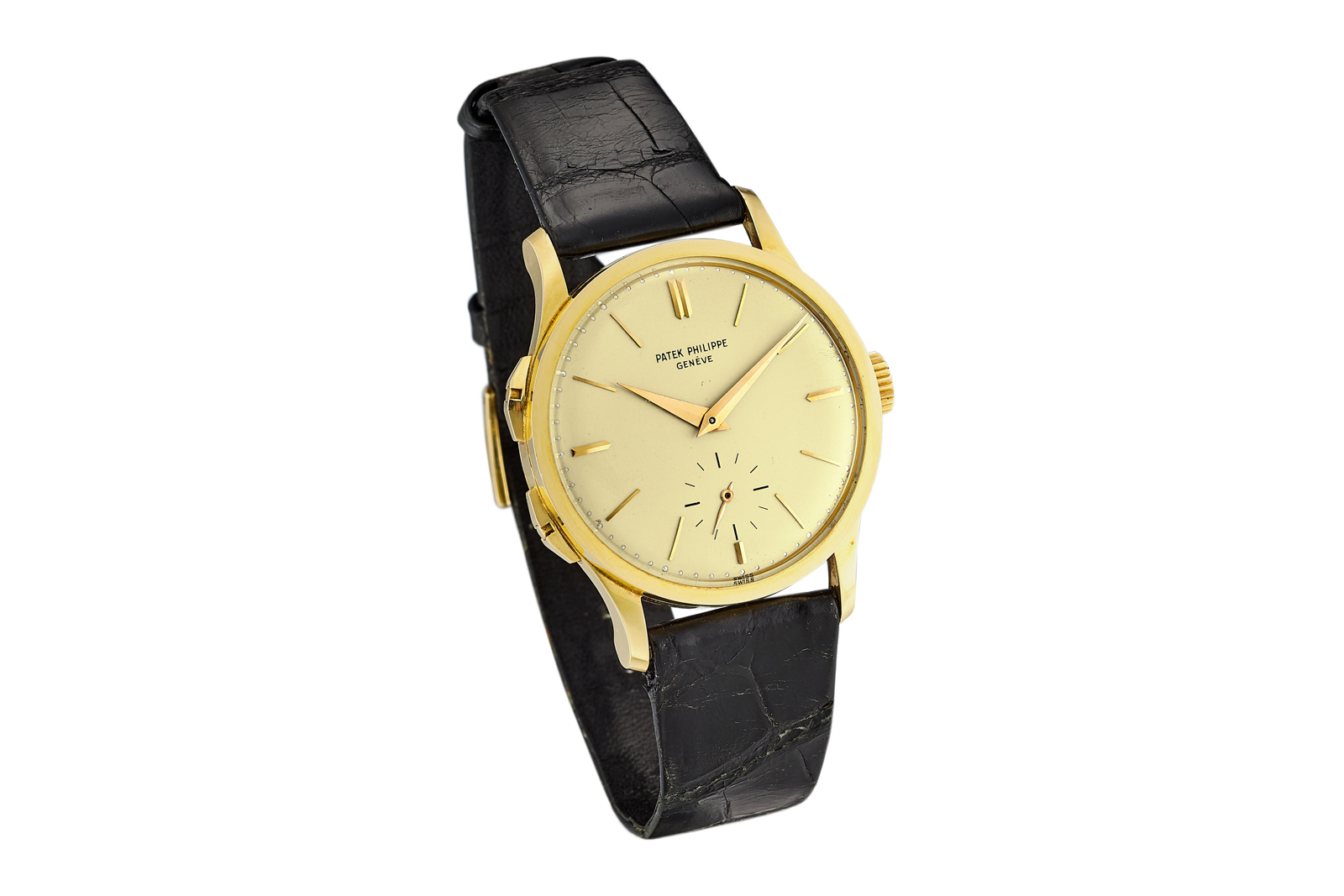
Interestingly, like the world time mechanism, the Travel Time complication was developed by Louis Cottier. But his original concept only encompassed an independently adjustable hour hand displaying a single time zone. Patek Philippe later modified the ref. 2597 to include an extra hand to show a second time zone, and offered existing owners of the model the opportunity to upgrade their watches.
This makes the current example extra special because it retains the original, single-time zone configuration, which is technically inferior but all the more interesting.
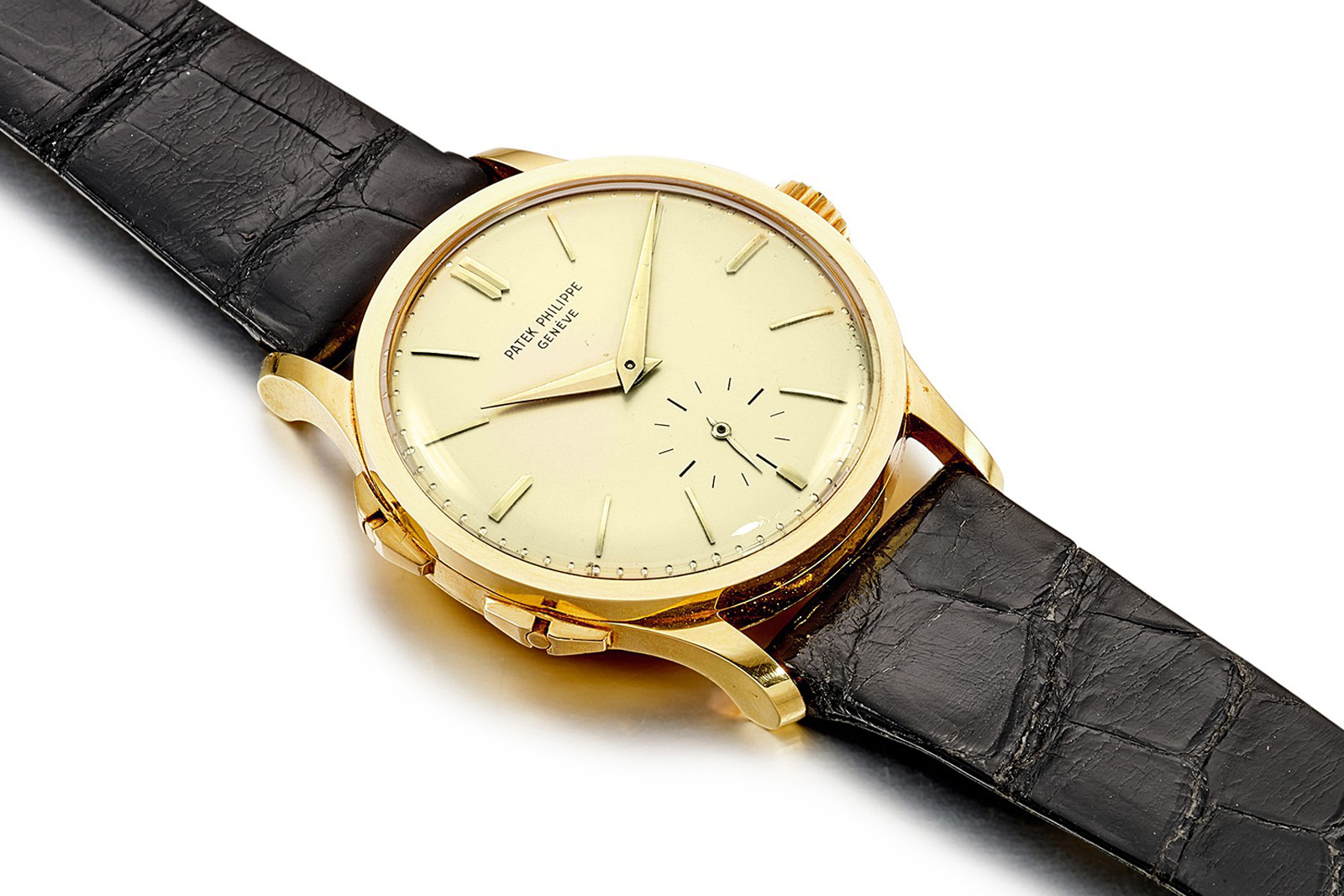
As is typical of vintage Patek Philippe, the ref. 2597 is classically beautiful
The ref. 2597 has an estimate of HK$1.0-2.0 million, or around US$128,000-257,000. Full lot details here.
Lot 2255: Rolex Day-Date ref. 1803 “Submariner”
Last but not least is the most interesting Rolex in the sale – and the only Rolex amongst the highlights – a Day-Date ref. 1803 that’s truly atypical.
The ref. 1803 was offered with a variety of dials, including semiprecious stone, wood, and glossy lacquer, but they are uniformly conservative in style. This example, in contrast, is a Submariner-style dial that was requested by the original owner, a Swedish gentleman.
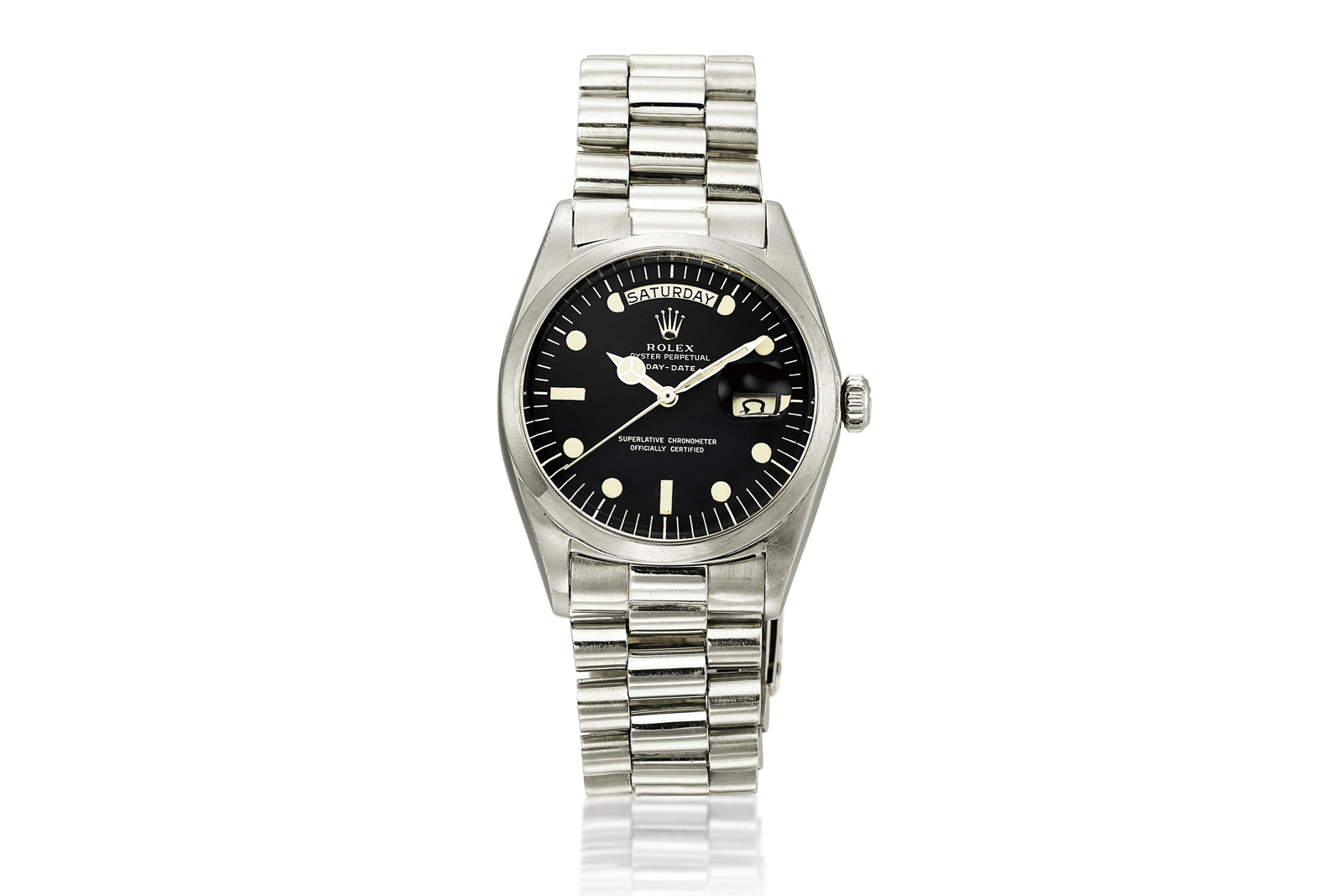
Sold in 1969, the watch is very much a standard Day-Date ref. 1803 in white gold, save for the dial, which is a matte black and features luminous hour markers just like in a Submariner or Sea-Dweller.
And it’s even matched with the “Mercedes” hands to boot, though the seconds hand is typical of the Day-Date, instead of the luminous seconds hand found on the diver’s watches.
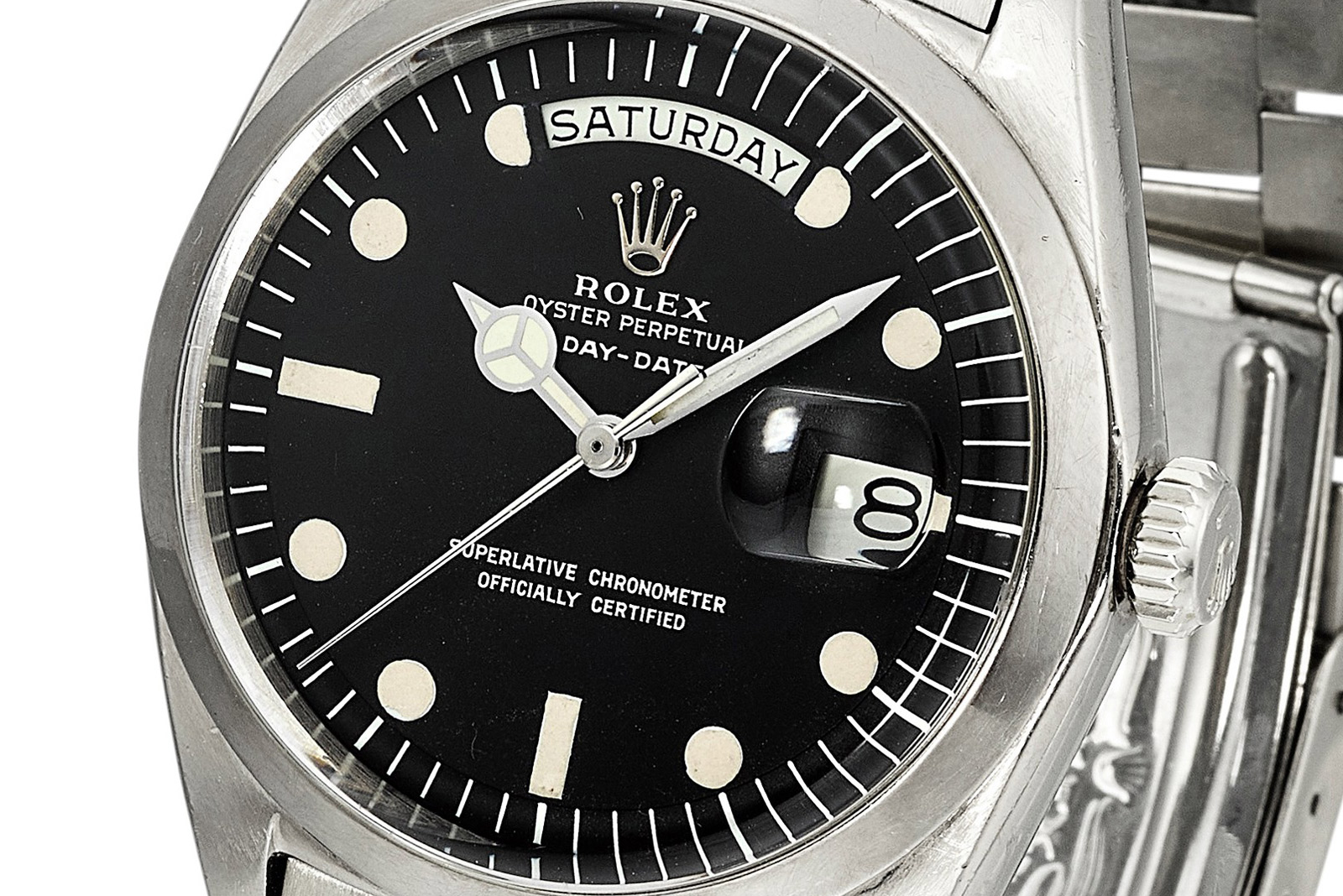
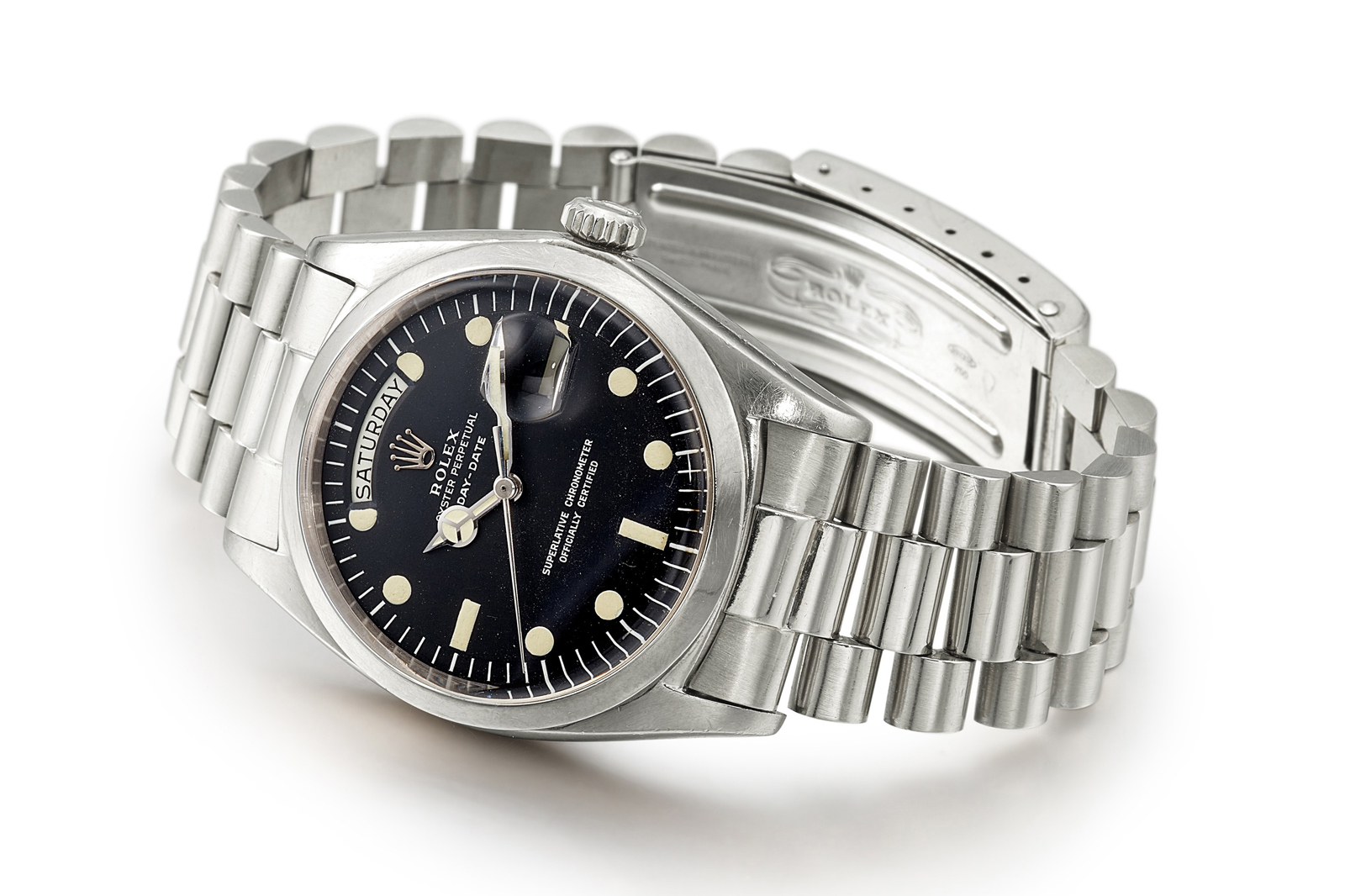
The bezel is flat, which suits the no-nonsense dial better than the fluted bezel most commonly found on the Day-Date
Unique Rolex watches are often subject to scholarly debate. This watch, however, has impeccable provenance, which was documented with photos and paperwork that were presented the first time the watch was sold at Christie’s in Geneva, where it sold for CHF275,000 fees included. On that occasion it was consigned by the son of the gentleman who ordered it. And the watch has also been serviced by Rolex on several occasions over the decades, most recently by Rolex Geneva in 2017.
One other Day-Date exists with the same dial – according to Christie’s, when the original owner of this example collected his watch in 1969, another client in the store happened to see it, and wanted exactly the same thing.
Unfortunately, the documents that came with the watch when it was first sold have been lost. The Rolex Day-Date “Submariner” has an estimate of HK$0.8-1.6 million, or around US$103,000-206,000. Full lot details here.
Preview and Auction
The preview exhibition is open daily from October 7-12 at the New Wing of the Hong Kong Convention & Exhibition Centre (HKCEC).
The auction starts at 2:00 pm (GMT+8) on October 13, 2021 taking place at Sotheby’s offices in Pacific Place.
5/F, One Pacific Place
88 Queensway
Admiralty
Hong Kong
China
For the full catalogue, as well as registration and online bidding, visit Sothebys.com.
This was brought to you in collaboration with Sotheby’s.
Back to top.
